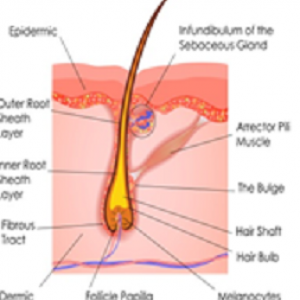
Although it seems popular to believe that the main cause of hair loss is our toddlers, or perhaps it’s the teenagers, (and clinical research does corroborate stress as a trigger in some cases (1,2)), hair loss can be a symptom of multiple diseases/disorders.
Like the blades of grass that carpet the golf course, our hair is rooted into our scalp. Specifically, hair grows from the hair follicle. Moreover it has been estimated that anywhere from 250,000 to 500,000 hair follicles exist on the human scalp (3). Each of those follicles often contains multiple strands of hair. It is when the hair follicle is no longer functioning properly that hair loss can occur.
Though there can be many causes, male pattern baldness is probably a familiar term. An approximated 70% of men and 40% of women will be affected at some point throughout life (3). Changes in hormones can promote the shrinking of the scalp hair follicle until it gradually ceases to produce hair (4). The result is an increase in facial hair and a decrease in hair on the scalp. Men may notice a hairline recession at the temples and top of the head while women are more likely to experience a general thinning throughout that progressively increases with age.
But there are many other reasons for hair loss. If this description does not sound like you, alopecia areata is another condition resulting in hair loss and affects approximately 2% of the population (5). In this case, it is the immune system that attacks the hair follicle. Even more frustrating, the immune system selectively targets actively-growing coloured hair, leaving the older, gray hairs behind (6). More extreme than male pattern baldness, variations of alopecia areata can cause patchy hair loss on the scalp, complete loss of scalp hair or complete loss of all hair throughout the body.
Overall, although the root cause of your hair loss might not be simple or straight forward, your team at Sure Hair can help identify your situation and discuss the options best for you.
Article by: Dr. J.L. Carviel, Mediprobe Research Inc.
References
- McElwee KJ, Gilhar A, Tobin DJ, Ramot Y, Sundberg JP, Nakamura M, et al. What causes alopecia areata? Exp Dermatol. 2013 Sep;22(9):609–26.
- Peters EMJ, Liotiri S, Bodó E, Hagen E, Bíró T, Arck PC, et al. Probing the effects of stress mediators on the human hair follicle: substance P holds central position. Am J Pathol. 2007 Dec;171(6):1872–86.
- Santos Z, Avci P, Hamblin MR. Drug discovery for alopecia: gone today, hair tomorrow. Expert Opin Drug Discov. 2015 Mar;10(3):269–92.
- Kaufman KD. Androgens and alopecia. Mol Cell Endocrinol. 2002 Dec 30;198(1-2):89–95.
- Gilhar A, Etzioni A, Paus R. Alopecia areata. N Engl J Med. 2012 Apr 19;366(16):1515–25.
- Paus R, Slominski A, Czarnetzki BM. Is alopecia areata an autoimmune-response against melanogenesis-related proteins, exposed by abnormal MHC class I expression in the anagen hair bulb? Yale J Biol Med. 1993 Dec;66(6):541–54.












